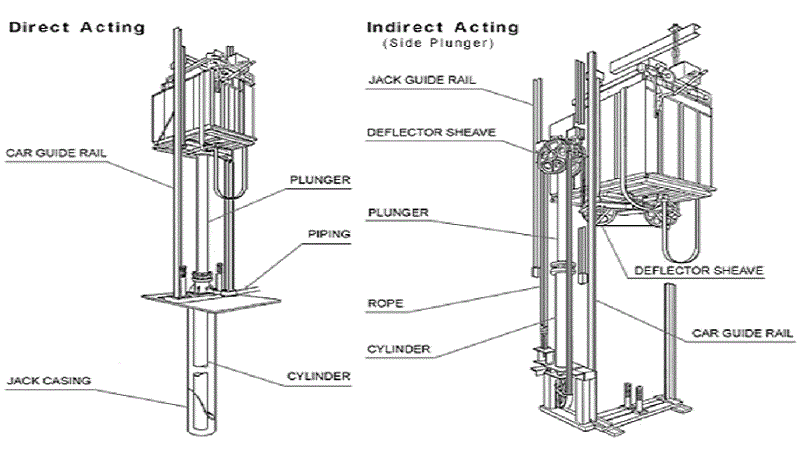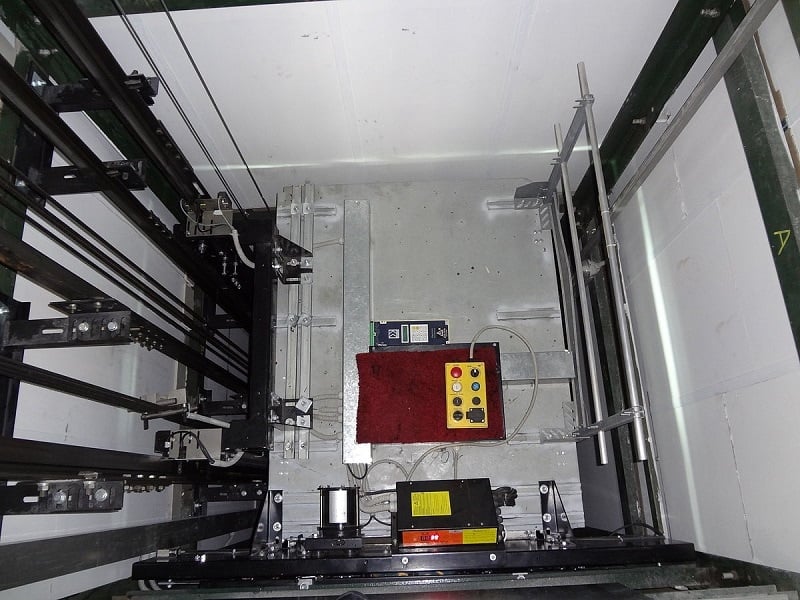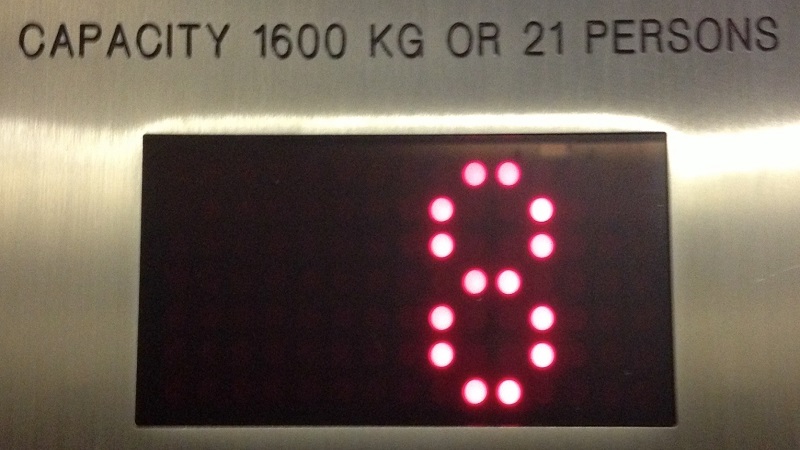The weight of an elevator varies based on its design and location, but it generally ranges from 2,100 to 6,000 pounds (about 454 to 2,722 kg). The elevator’s floor dimensions, material, and support structure all plays a role in this figure.
Elevators in tiny residential buildings or private dwellings tend to be the smallest and have the lowest weight restrictions. Elevators meant to transport people and materials up buildings are usually built differently and can sustain much more weight.
Curious about learning about the weight of the different kinds of elevators we have? Keep on reading this piece for more information!
Types of Elevators and Their Average Weights
There are so many types of elevators with different uses, which makes the weight of elevators not uniform. While there is a range of possible weights, checking out the types with corresponding weights and uses is essential.
More interesting are the prospects they offer in terms of use!
Stay tuned:
Traction Elevator
Average weight: 4,400-15,400 lbs (2,000-7,000 kg)
The most prevalent type of elevator is a traction elevator (also known as an electric elevator). Rolling steel ropes pull elevator cars up a deeply grooved pulley known as a sheave in the industry.
Since 1900, a counterweight has balanced the car’s weight. Two elevators are sometimes built so that their cars always move in opposite directions and act as counterweights to each other.
Instead of traditional steel ropes, some traction elevators now use flat steel belts. Due to its carbon-fiber core and high-friction coating, flat steel belts are incredibly light and do not require any oil or lubricant. Elevator energy usage in high-rise buildings can be significantly reduced because of these characteristics.
There are two kinds of traction elevators: geared and gearless. These elevators weigh at least 4,400-15,400 lbs (2,000-7,000 kg) when empty and can move between 500 to 2500 ft per minute. This makes them a perfect fit for large establishments where they can sustain up to 30,800 lbs (14,000 kg) of carry load.
Geared Traction Elevator

Average weight: 8,400-17,600 lbs (3,800-8,000 kg)
Geared Traction Elevators are powered by alternating current (AC) or direct current (DC) electric motors. This design uses an electric motor to drive a worm-and-gear reduction unit, which rotates the hoisting sheave, as implied by the name of the design.
As a result of the gear reduction, lift rates are slightly slower than those of a standard gearless elevator, but the elevator requires a far less powerful motor to turn the sheave.
A standard geared traction elevator’s speed ranges between 38 and 152 meters (125 and 500 feet) per minute and can handle up to 30,000 lb (13,600 kg) loads.
The elevator is stopped by an electronically operated brake between the motor and the reduction unit, which keeps the vehicle at the chosen floor level. When empty, this elevator weighs around 8,400-17,600 lbs (3,800-8,000 kg) and can be used in large buildings.
Gearless Traction Elevator
Average weight: 8,800-15,400 lbs (4,000-7,000 kg)
The gearless Traction elevator was initially used in 1913. The electric elevator was first built in the Woolworth Building in New York City, followed by the Majestic Building in Chicago a year later. It is possible to use this type of drive system in buildings of any height, and it can run at far faster speeds than traditional steam-powered elevators.
They typically move at rates greater than 500 feet per second. Gearless elevators have proven so long-lasting that they are rarely replaced even now when a building is modernized. Only the elevator control system is upgraded to the most up-to-date electronics.
Gearless traction elevators can go up to 2,000′ (610 m) per minute and can reach speeds of up to 2,000′ (610 m) per minute (610 m). They weigh around 8,800-15,400 lbs (4,000-7,000 kg) when they are empty. Moreover, they are an excellent fit for large buildings since they can carry up to 30,900 lbs (14,000 kg).
Roped Hydraulic Elevator

Average weight: ~4,000 lbs (1,800 kg)
Hydraulic elevators are lift systems that raise and lower the elevator car using a hydraulic piston. Due to the elevator system’s slower speed and limited piston lengths, hydraulic elevators are mainly employed for low-rise and mid-rise buildings under 6 stories. They come in various shapes and sizes, as we’ll see as we go along.
The ropes hydraulic elevator, which has a capacity of over 6,000 pounds and a curb weight of 4,000 pounds, is the source of our concern. Roped hydraulic elevators hoist the elevator vehicle with the help of a hydraulic jack and cables. This allows you to enjoy the smooth ride of a hydraulic elevator without digging a large hole in the ground.
The hydraulic jack is located between the rails in the hoistway. The jack’s top is equipped with a pulley. Two hoisting wires connect everything. The cab is attached to one end. The opposite end is connected to a fixed point at the rails’ base.
An adjacent machine room houses the controller and hydraulic pump. A shallow pit is required for this elevator, and it’s common in residential buildings.
Conventional Hydraulic Elevator
Average weight: ~2,000-4,000 lbs (900-1,800 kg)
It has an elevator pit with a sheave that extends beneath the pit floor and is designed to be utilized with an elevator. It can travel a maximum distance of about 60 feet. During the elevator’s descent, the pit acts as a support for a retraction piston.
A smaller hole below the pit may be necessary to accommodate a telescopic piston collapsing when the elevator is descending to a lower level if a traditional hydraulic elevator is employed.
Traditional hydraulic elevators are very common in homes since their specifications are acceptable for the intended application. They weigh between 2,000 and 4,000 pounds (900 and 1,800 kg) when not in use and have a carrying capacity of 3,000 to 4,000 pounds (1,360 and 1,800 kg.)
Hole-less Hydraulic Elevator
Average weight: ~3,000 lbs (1,360 kg)
The Hole-less Hydraulic Elevator is similar to the conventional hydraulic elevator. At the bottom of the pit, it has telescopic pistons. Thanks to these pistons, the elevator car may go a maximum distance of 50 feet.
A non-telescoping piston design is also available, allowing for movement of up to 20 feet in either direction. But, it does not require the installation of a hole or sheave below the pit.
The hole-less hydraulic has a 3000-pound (1,360-kilogram) curb weight and 2,000-4,000 pounds (900 and 1,800 kg) carrying capacity. It’s an ideal choice for mid and low-rise buildings. Various manufacturers make it in different ways.
Machine Room Less(MRL) Elevator

Average weight: 1,300-3,500 lbs (590-1,590 kg)
Machine-Room-Less (MRL) elevators are modern traction lift systems that hoist the elevator car using an electric hoisting machine placed at the top of the elevator shaft.
The Machine-Room-Less (MRL) Elevator, which eliminates the need for a penthouse machine room in Traction Elevators, is gaining popularity since it takes up less space, is energy efficient, and efficiently meets the speed and travel needs of mid-rise structures.
Less-Machine-Room (MRL) Elevators go at a maximum pace of 500′ (152 m) per minute and can travel up to 250′. (76 m). The highest elevator landing must have a control room next to the elevator shaft and within 150′ (46 m) of the machine.
Mid-rise buildings are increasingly using MRL elevators since they save energy and take up less space during construction. It’s ideal for the home! They range in weight from 1,300 to 3,500 pounds (590-1,590 kg), with a carrying capacity of up to 4,000 pounds (1,800 kg).
Vacuum(Air Driven) Home Elevator
Average weight: 350-900 lbs (160-410 kg)
Vacuum elevators, which were first introduced to the elevator industry in 2005, work without the usage of cables or pulley systems. The natural principles of physics govern the operation of these air-driven elevators.
This lift system is just a tube in a sealed vacuum, made of polycarbonate and aluminum materials. The air aids movement beneath and above the elevator car.
When you press the up button, the system decreases the pressure above the tube, allowing the air pressure below to push it higher. However, the pressure below decreases as you descend, pushing the elevator to descend.
This elevator is usually employed in residential applications because it comes in three different models, ranging from a single passenger to a three-passenger wheelchair-accessible model. This elevator can transport between 400 and 850 pounds (180-385 kg) and has a curb weight of 350 to 900 pounds (160-410 kg).
How Much Does a Commercial Elevator Weigh?

Commercial elevators are often built to hold a more significant number of people than residential elevators. Because they receive fewer users than commercial elevators, house elevators can only handle one person in some circumstances.
Elevators for passengers are classified based on their cab weight capacity, cab size, and elevator speed. Commercial lifts are classified as weighing between 2,100 and 5,000 pounds in cab weight categorization.
The cab width must be 51 inches deep and 68 inches wide to accommodate the most significant number of people. Elevators in commercial buildings and multi-story residential complexes must be positioned in easily accessible areas for individuals with disabilities, according to the Americans with Disabilities Act (ADA).
The location of the elevator stops on the elevator shafts is one significant difference between passenger elevators in high-trafficked structures. Commercial elevators, unlike residential elevators, are not mandated to stop on every floor.
These containers are classified as express elevators because they only serve specific floor levels or transport passengers from the lobby to the highest floor, or ‘penthouse,’ of a building. Modern commercial multi-floor lifts are often high-speed traction elevators that convey customers to their preferred floor level in seconds.
How Much Does a Standard Elevator Weigh?
The word standard elevator also refers to residential or home elevators. A two- to six-story home can usually accommodate a standard elevator. Home elevator travel height is limited to 50 feet by the American Society of Mechanical Engineers (ASME).
What about the proportions of a house elevator? A minimum of 5′ x 5′, or 25 square feet of floor space is required when constructing an elevator in your home.
What if you don’t have the extra 25 square feet in your home? Even if you have a limited amount of space, the right elevator business should be able to develop a solution that meets your requirements.
The ASME regulates elevator dimensions for safety. A 15-square-foot inside cab is standard for a house elevator. There isn’t a conventional length-to-width ratio, though. The available space is the primary constraint on the size of your home elevator.
Homeowners use 40″ x 54 or 36″ x 60 as standard sizes. In addition, municipal building requirements stipulate that residential elevator doorways are at least 32 inches wide.
Some firms only provide a 12-square-foot cab as a regular feature. On the other hand, the inner cab of a 15-square-foot truck can be used for various tasks. The cab can accommodate a group of people or individuals who use a wheelchair with a companion.
Most residential elevators can support up to 950 pounds and have an average weight of 850 pounds.
How Much Does a Freight Elevator Weigh?
Freight elevators are big elevators used to transport items between floors of a building. As a result, they are frequently larger than standard commercial elevators intended for passengers. Freight elevators typically handle between 5,070 and 9,920 lbs (2,300 and 4,500 kg) of cargo, and their interiors are usually tough to prevent damage during loading and unloading.
While freight elevators are primarily used to transport freight, some also accommodate passengers. This can be accomplished by using a low-profile riser that allows people to travel with the products.
Because traction is more effective for moving big weights, most freight elevators employ it instead of hydraulics. Hydraulic freight elevators, on the other hand, do exist. Furthermore, freight elevators weigh on average 5,500 lbs (2,500 kg).
How do You Calculate Elevator Load?

The ASME A17.1 elevator code mandates a close relationship between elevator size and capacity. To put it simply, the larger the elevator cab, the heavier it can hold.
Although elevator capacity is usually computed based on elevator size, it is not the only factor to consider. Also, the building’s height, how the cab is lifted, and the materials used can affect the weight limit.
There are three approaches to calculating how many passengers an elevator cab can safely carry. These are:
Max loading
Max loading refers to an elevator’s maximum capacity. It is the elevator’s capability but should only be used in dire cases. A max load would not be a comfortable ride.
To calculate the maximum load, allow 1.5 square feet per person.
Normal Loading
Normal loading is the recommended amount of persons in an elevator. The elevator should be able to move 10-12 percent of the building’s occupants in five minutes. Even though it’s called normal, most people regard it as a crowded elevator and will wait for the next one.
Allow 2.3 square feet per person to compute the usual load.
Special Loading
Special loading is used in situations where the other two types of loading are not appropriate. It is for buildings with passengers who may need heavy products or equipment. This reduces the elevator’s capacity.
To compute the special load, allow for half the regular load.
How Much Does an Elevator CounterWeight Weigh?
Elevators operate in a somewhat different manner than conventional hoists. The elevator car is balanced by a massive counterweight that weighs around the same as the vehicle when half-filled (the car’s weight plus 40–50% of the total weight it can transport). The counterweight falls as the elevator rises.
The counterweight makes it easy for the motor to raise and lower the car, similar to how lifting someone’s weight on a see-saw is much easier than lifting them in your arms. Because of the counterweight, the motor requires substantially less force to push the vehicle up or down. If the car and its contents are heavier than the counterweight, the engine just needs to lift the difference in weight and exert extra effort to overcome friction in the pulleys and other components.
Hence, Elevator counterweights don’t have a specified weight across all elevators. Here’s an ideal way to calculate it:
Formula: Elevator Counterweight = 1/2 of Maximum Elevator Capacity + Cab Weigh
If the Maximum Capacity of the Elevator = 3,000 lbs.
and , Cab Weight = 2,000 lbs.
1,500 lbs + 2,000 lbs
Elevator Counterweight = (3,000 / 2) + 2,000 = 3,500 lbs
Is an Elevator a Live or Dead Load?
The first vertical load that must always be considered is dead loads. This form of load frequently includes all beams, the roof, columns, walls, and other structures. These loads are always present and will remain in the structure. A permanent partition wall, a structural element, and permanent equipment are all examples of dead loads.
Live loads, on the other hand, are either moving or movable loads that have no impact or acceleration. These loads are part of what a resident brings into the structure and are referred to as imposed loads. Furniture and movable dividers are typical examples of these objects.
As you can see from the explanation above, elevator machinery is dead load.
Final Thoughts
Well, there’s so much information about the weight of elevators. There are several kinds with different weights and peculiarities across several manufacturers. This makes it essential to check every detail about any elevator you wish to procure. The contents of this piece on the weight and loading capacity of elevators would be a handy resource for you!






